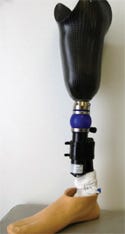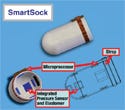Prosthetic Sock Relieves Patients under Pressure
June 1, 2008
R&D DIGEST
|
The SmartSock has pressure sensors and elastomers embedded inside the fabric to redistribute pressure. |
A student at the University of Pennsylvania (Philadelphia) has developed a prosthetic sock that relieves and redistributes pressure for below-knee amputees.
Transtibial amputees can experience severe pain, pressure, friction, and skin degradation when walking and using a prosthetic device. Placed underneath the prosthetic device, the SmartSock has pressure sensors and elastomers embedded inside the fabric to redistribute this pressure.
“You're able to redistribute the pressure in the residual limb by having these elastomers expand and push the fabric of the sock outward, so that the pressure lies on these now-protruding areas of the socket,” says Chrysta Irolla, a senior at the university's School of Engineering and Applied Science.
Irolla came up with the concept for the device after working with lower-limb amputees in China. She noticed that the patients who wanted to live the most active and normal lives were developing sores on their limbs. This led to either removing the prosthetic until the wound healed or further amputation due to infection.
|
The dielectric elastomers of the SmartSock are a special type of rubber that changes when voltage is placed across the material. The SmartSock has a sensor, a microprocessor, a drive circuit, and dielectric elastomers, which are all connected via circuitry components. |
“When I came back to the United States, I thought there had to be some sort of solution to this,” Irolla says. “I really didn't find anything that actively addressed the problem; it's just something that the amputees [had] learned to live with.”
After consulting with prosthetists, Irolla began designing the prosthetic sock. The device also won her the grand prize at the university's PennVention competition for student inventors.
The device has a sensor, a microprocessor, a drive circuit, and dielectric elastomers, which are all connected via circuitry components. The dielectric elastomers are a special type of rubber that changes when voltage is placed across the material.
A sensor is placed in strategic areas where pressure accumulates in the limb. It sends information to a small processor located outside of the sock. Once a certain pressure threshold is reached, the sensor sends voltage to a drive circuit to activate the elastomers. As the voltage is placed across the elastomers, they expand and contract.
Current options for relieving pressure in transtibial amputees include polyurethane liners that are stacked to create cushioning and a device that absorbs pressure while walking. Irolla says these products provide only passive cushioning and don't dynamically change the pressure profile.
The SmartSock will come in about eight liner sizes, which will vary in length, since below-knee amputation can occur at several different heights. Within each of the four different heights of the elastic material, there will be a thinner size and a wider one.
A small battery located in a pocket on the side of the sock will power the device. Irolla hopes to make it last one week before it needs to be changed. However, the battery's attributes will depend on the voltage per micron and how much power is necessary to power the circuit.
The biggest challenge likely will be optimizing the voltage per micron in which to attain a change in the elastomer. The device needs to have the smallest amount of voltage to achieve the 1- or 2-mm change that is necessary to redistribute pressure.
Irolla's next plans are to talk with patients and explain how her prototype works. She will be using patient feedback to further refine the product. At the end of the summer, she wants to start looking for more funding to launch the product into clinical trials and FDA approval.
Copyright ©2008 Medical Device & Diagnostic Industry
About the Author(s)
You May Also Like




